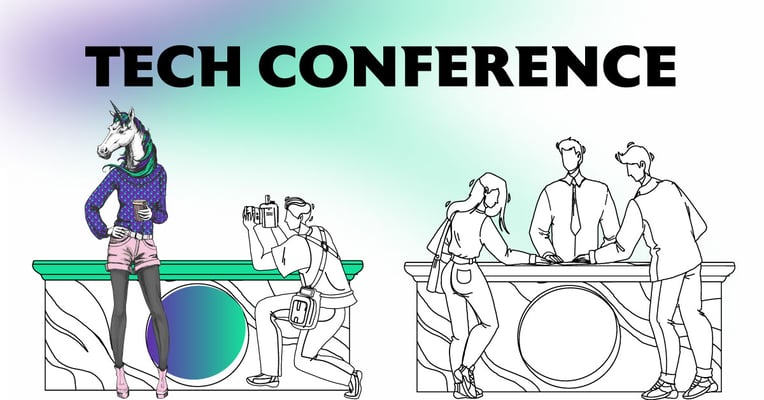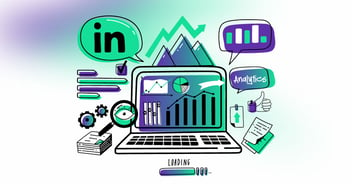
This Is How You Stand Out in B2B Tech Trade Shows
If you've been to a mega tech trade show, you'll immediately know what we’re talking about. Several hundred, if not thousands of vendors fight for the attention of their captured audience over a 3-day period. It's a mess.
The most prominent challenges beloved B2B tech marketers struggle with include:
- Cutting through the noise: International conferences attract tens and hundreds of thousands of attendees, exhibitors, and sessions, leading to a deluge of information. Standing out and ensuring your message reaches the right audience can be a daunting task.
- ROI and planning required for conference marketing: Participating in international conferences entails significant financial investments, including booth rental, design and set up, travel expenses, marketing collateral production, etc. An “unsuccessful show” is not an easy pill to swallow.
While captivating attendees is important, it's equally essential to convert those interactions into tangible business opportunities. This involves nurturing relationships, delivering value, and transitioning from an engaging booth experience to meaningful conversations and follow-up actions. I mean, what’s the point in all the glitz and glamour if they don’t bring in sales, right?
Overcoming Mega Trade Show Challenges: Creativity, and Planning
Let’s take, for example, the world's largest annual cybersecurity conference, RSA (or the forthcoming annual Black Hat conference). They shout, "Break free from outdated messaging! Embrace creativity and innovation!"
Here are some golden rules to make the most of your investment.
Before the event: Plan, plan and plan some more...
Relying solely on foot traffic is not enough for companies to generate leads and ensure ROI. Companies also need to proactively seek out and engage with potential clients by initiating physical meetings at their booths. In advance of the event, send targeted invitations, follow up before and after the event, organize meetings, and generate genuine interest with potential clients.
Think about your audience. Who do you want to meet there? What pain points do they need to alleviate? Create campaigns targeting them, in a good old-fashioned and methodical B2B marketing way. Segment different audiences, create G2M strategies, and utilize social media to make your presence known.
During the event: Don’t be boring, stand out!
Yes, having (yet another) a black, blue, and white brand can be depressing…. But you can still have fun and stand out. Get a band, set up a cool game, put boxers in a ring, or rappers on a stage. Bring a goddamned unicorn if that is what you need. Just don't settle for the roll-up.
And no, booth babes are no longer an option. (Did we just write that?)
If this sounds like a lot to grasp - it should. You need to plan thoroughly well beforehand to get the most out of the event, be well prepared but stay creative and innovative at the same time, and your work doesn’t even end with the event, there’s still so much to do afterward. If there’s one question that might help you go through all of these steps successfully, it’s this: how can my booth turn into a conversation? How can my presence at the event make people talk?
Some well-established companies like Check Point understand the importance of creativity and initiative in the dynamic cybersecurity landscape.
“Give us some examples”
Check Point's team, for instance, created baseball player costumes and a massive baseball glove at their booth. Visitors were encouraged to take photos with the glove and share them on social media, turning the booth into a viral sensation. This clever incorporation of a familiar theme from the world of baseball generated buzz and engagement. Also, participants who tagged Check Point in their photos were entered into a raffle with a chance to win $500, further incentivizing interaction and
amplifying their booth's visibility. BRILLIANT!
Another legendary cybersecurity company, Pentera, turned its exhibit space during a Black Hat USA 2022 event into a boxing ring with referees and their staff wearing T-shirts that said: "We're In Your Corner."
After the event: Follow up with leads. Duh…
After the exhilarating experience of attending conferences, companies must shift their focus to standing out when following up with prospects. Think about it, the lead you are about to contact may have left contact info with up to a dozen other companies who want the same thing you do.
When it comes to reaching out to people, it's easy to get carried away and start bombarding them with emails or making rapid-fire sales calls. But hold on a minute, there's a better way to make a meaningful connection. It's all about timing, my friend. And sometimes, that means waiting longer than you'd prefer. You see, after a conference, folks are drowning in a sea of emails and calls. They might have even taken a couple of days off to attend the event, so they're swamped with catching up on their regular work messages. So, when should you reach out? Well, there's no one-size-fits-all answer, unfortunately.
As a general rule, though, it's a good idea to give it a few days after the conference wraps up. Give it two or three work days to allow them to resurface from the email madness.
The post-conference phase is where the hard work truly begins. It involves strategic and innovative actions that maximize the impact and extract value from the connections and leads generated during the event.
For example:
- Sift through the contacts: Separate them into piles in order of priority based on intent to close/opportunity
- Scheduling follow-up Meetings: One of the immediate priorities is to schedule follow-up meetings with the leads and potential clients collected during the conference. The sooner the better to maintain momentum and capitalize on the interest generated at the conference.
- Nurturing Relationships: Companies should develop a structured approach to maintaining communication and providing ongoing value to potential clients. This can involve personalized follow-up emails, sharing relevant industry insights, or offering exclusive content that addresses the needs and pain points discussed during the conference.
- Use your digital platforms. Actively engage with attendees on social media, share conference highlights, and photos, and continue the conversation in online communities or industry-specific forums. This multi-channel approach strengthens brand visibility, keeps the conference experience alive, and reinforces connections made during the event.
Ready to take your B2B tech marketing to the next level and stand out among competitors?
Partner with Envy, a marketing and Revops agency specializing in B2B tech.






